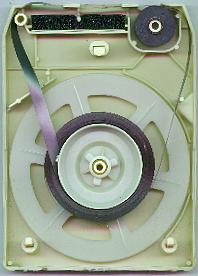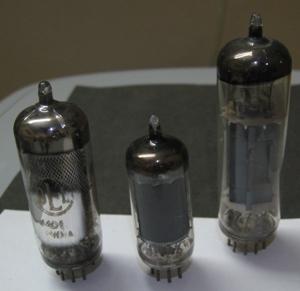
Transistors
IBM Punched Cards had 80 columns with 12 punch locations on each.
Data storage
Floppy Disks: With the advent of magnetic storage, floppy discs became very handy. They consisted of a plastic platter coated with magnetic material to store data. They were so unreliable compared to the flash memory and optical storage devices we have today that my friends and I had to submit multiple copies for our college projects to avoid getting a zero for non submission resulting due to a nonreadable disk:) Floppy discs came in different sizes and stored up to a mere 1.44 Megabytes. I can recall we used zipping/splitting software like PKZIP to load large files onto multiple floppies. Well, considering the fact that my first computer had 850MB of hard disc capacity, a 1.2 MB floppy was great amount of space at that time compared to a 4 GB pen drive that I use today with a 320 GB hard drive:)
Audio / Music Storage
Tape Storage
A 386 (pre-pentium) laptop with a trackball from the early 1990s in my
collection
(And yes, its still in working condition)
Compact Disc Audio (CD): Before graduating to thumb sized MP3 players from cassettes many of us have enjoyed Audio CDs (eponymous CD quality recording) in the interlude. Though most of the music sold at stores today is still in ACD format, MP3 and WMA conversion and subsequent transfer to portable music devices has decreed that we (or at least I) don't use that Audio CD more than a couple of times during its lifetime :)
A MiniDisc (MD) is a magneto-optical disc-based data storage device intended for storage of up to 80 minutes of digitized audio. MiniDisc was announced by Sony in 1992. MiniDiscs were popular in Japan as a digital upgrade from cassette tapes. The disc is permanently housed in a cartridge (68 × 72 × 5 mm) with a sliding door, similar to the casing of a 3.5" floppy disk. Recordable MiniDiscs use a magneto-optical system to record data.
And finally ...
Digital Music
Stereo 8 tape cartridge. (the picture showing the innards of the 8 track tape has been taken from the internet. I didn't want to rip apart mine:) )
Normal cassette allowed upto 90 mins of playback
This 7 inch, 45 rpm Extended Play record can playback for 4 mins per side.

While I grew up in the late 80s and 90s audio cassettes were the only source of recorded music at home. I have a huge collection of cassettes and I'm sure most of you reading this would be having stackfulls too... but let me ask you when was the last time you used them :) I haven't turned on the tape player in years ever since MP3 music has made things compact. A closer cousin of the cassette is the 8 track tape which I picked up in a garage sale. This type of magnetic tape recording system also known as Stereo 8, was very popular in the United States from the 1960s to early 1980s and was promoted by a consortium comprising RCA Victor, Motorola and General Motors among others.
This 12 inch, 33.5 rpm record is termed Long Play and playsback for 45 mins.
Gramophone records made of Lac and later on Vinyl largely replaced Edison's phonograph cylinder and the records are popular even today. Records are analog sound recording mediums comprising a flat disc with a grooved surface that is inscribed with a pattern that we hear as sound, when decoded by the record player's electromagnetic head (voice coil)
Digital Data Storage (DDS-2) cartridge data tapes store 4 GB of data on 124 m of 4mm width tape. Tapes are used even today for data back up in large corporations because of their reliability.
After the success of the 100 MB Zip disks, iOmega released the 1GB jaz disks in 1995. The ZIP drive used floppy disk technology while the Jaz used hard drive technology using rigid platters.
USB pen drives have made most of the older data storage systems obsolete except for CD/DVDs perhaps
The 8” floppy disk introduced by IBM in 1971 stored 80 KB and was upgraded to hold upto 1.2 MB by 1977. The 5.25” disk was launched in 1978 with a capacity of 360 KB and graduated to 1.2 MB by 1982. Other sizes were launched in between but none was as popular as the 3.5” HD introduced in 1987 which stored 1.44 MB
205 page Microfiche (left) and three magnified pages (top) from the book that can be read comfortably by using a fiche reader.
Microfilm / Microfiche system
A microfiche is an A6 size flat film (105 x 148 mm) containing micro-reproductions of documents for transmission, storage, reading, and printing. It carries a matrix of micro images. The most commonly used format is an image of about 10 x 14 mm. A4 or letter size papers require a reduction of 24 or 25 times. The Microfiche reader magnifies the images.
The Hollerith Punched Card system was used as a medium for input of both computer programs and data. Punched cards were first used in the mid 1700s to control textile weaving looms in Europe. The IBM card format designed in 1928 had rectangular holes on a piece of stiff paper that contained digital information represented by the presence or absence of holes in predefined positions. The reader had brushes that detected whether the position was punched or not. (binary 0 or 1) Punched paper tapes wound on spools too worked similarly.
The pins on the back of the packaging are connected to the die pads by gold or copper wires.
The die pads (the ends of the semiconductor chip) are connected to the pins/leads on the back of the packaging by gold/copper wires.
The die is mounted onto the packaging base (left) and wired (right).
The wafer after the gates (transistors) are etched. The wafer is scored (marked) and diced(cut) to individual dies
The wafer (left), new and un-etched. (about 0.7mm thick and 6" diameter)
The size of transistors has been reducing ever since the transistor was invented in the late 1940s. Millions of transistors are etched onto a silicon wafer and packaged to build an integrated circuit. The work is performed in a specialized facility called as fab. The wafer is first sliced out of a very high purity silicon ingot. The wafer is polished and then certain fabrication processes are carried out to etch out the transistors (logic gates). Interconnects are done with aluminium or copper. The wafer is tested and then diced (cut) to individual die(s) which are then packaged in ceramic or plastic packs. During packaging the die is mounted and the die pads are connected to the pins (leads) by gold wires. After this, the packaging is sealed.
Vacuum tubes
With the beginning of the 20th century, most computers used electronic switching and the key devices to facilitate such switching and amplification was done by Vacuum Tubes. Theses valves depended on thermionic emission. They were not very reliable, guzzled power & dissipated large amounts of heat (by today's standards) and the computers using these devices occupied large spaces. These tubes were no longer popular (good for collectors) after the advent of Transistors. However, there are some manufacturers still manufacturing these tubes for audio applications.

Blaise Pascal (1623-1662). Pascal's earliest work was in the natural and applied sciences where he made important contributions to the construction of mechanical calculators. Pascal was featured on French 500 Francs banknote
The Soroban (counting tray) is a Japanese abacus used even today. The Soroban is derived from Suanpan abacus which was imported to Japan from China in the 1600s. The Chinese abacus dates back to 2nd century BC.
Now let us look at a brief history of computing and data storage with the help of some exhibits from my personal collection. I have been trying to collect vintage computing devices for quite some time now and the images shown in this 'museum' :) are from my collection.
While my father's generation used sliderules, I have taken my TI-89 Titanium and HP 12c financial calculator for granted. The HP 12c has retained some old world charm by retaining the Reverse Polish Notation (postfix notation) where we enter the operands first and then the operator, i.e to perform 2 + 3 =, we have to enter 2,3 and then '+' :)
The Sliderule
Most functions available on a regular electronic scientific calculator could be performed on a sliderule. The Sliderule was conceptualized in the 1600s, was used mostly in the mid 1900s and lost popularity ever since the electronic scientific calculator from HP and TI hit the market in early 70s.
I first laid hands on a computer - an Intel 80286 machine in the early nineties in school primarily for playing DOS based games and later for BASIC programming. The computer labs in school mostly had similar systems with bulky monochrome CRT monitors and an overall ungainly form factor. Most of them lacked even hard disks and we carried 5.25" Floppy Disks to render those machines usable. In the mid nineties, my father got me my first computer, with an Intel 486 processor, an 850 MB harddrive and 4 MB of RAM. It did not have a CD drive or a soundcard (opted not to go for them as the cost forbade but it came with a colour monitor, a bonanza for me at that time.) The processor had only a heat sink and no cooling fan was needed. They were silent and slow machines then.
Today, with dual/quad core processors and cutting edge computing technology, its hard to contemplate as to how we managed all our needs (or wants?) with those antiquated machines. A day without access to a computer today cripples us and sometimes makes us feel depressed :) My mechanical engineer father who used slide rules in the mid 1960s not only for his academics but also for engineering design calculations at his workplace, always says that his generation could successfully build huge industries without computers and so sometimes questions me why the fuss is all about if the internet is down for a day. Well, his generation will find it difficult to envisage our plight :) Here's a view of his sliderule:
A good programmer is someone who looks both ways before crossing a one-way street. ~ Doug Linder